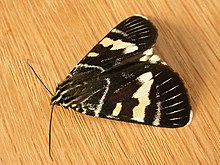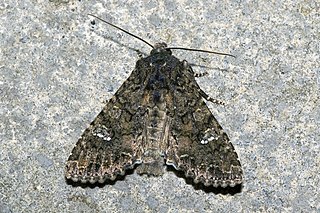
The cabbage moth is primarily known as a pest that is responsible for severe crop damage of a wide variety of plant species. The common name, cabbage moth, is a misnomer as the species feeds on many fruits, vegetables, and crops in the genus Brassica. Other notable host plants include tobacco, sunflower, and tomato, making this pest species particularly economically damaging.

Daphnis nerii, the oleander hawk-moth or army green moth, is a moth of the family Sphingidae. It was described by Carl Linnaeus in his 1758 10th edition of Systema Naturae.

Theretra oldenlandiae, the impatiens hawkmoth, taro hornworm or white-banded hunter hawkmoth, is a member of the family Sphingidae.

Hyles euphorbiae, the spurge hawk-moth, is a European moth of the family Sphingidae. This hawk moth is used as an agent of biological pest control against the noxious weed leafy spurge, but usually only in conjunction with other agents. The larvae consume the leaves and bracts of the plant. The species was first described by Carl Linnaeus in his 1758 10th edition of Systema Naturae.

The Mediterranean flour moth or mill moth is a moth of the family Pyralidae. It is a common pest of cereal grains, especially flour. This moth is found throughout the world, especially in countries with temperate climates. It prefers warm temperatures for more rapid development, but it can survive a wide range of temperatures.
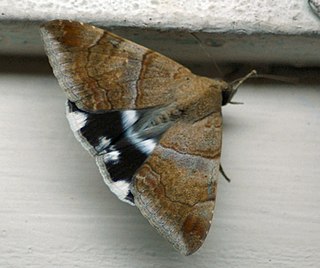
Achaea janata, the castor semi-looper or croton caterpillar, is an erebid moth, the caterpillars of which are termed 'semi-loopers' due to their mode of locomotion. It is found from the Indo-Australian tropics and subtropics, extending south to New Zealand and east through the Pacific archipelagoes to Easter Island. It is a major pest of castor throughout the world.
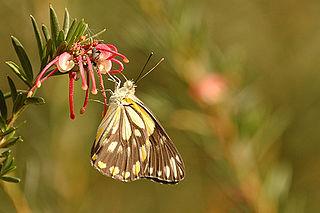
Belenois java, the caper white or common white, is a small butterfly of the family Pieridae found in Australia, Indonesia, and Melanesia. It is highly migratory and is often confused with the cabbage white.
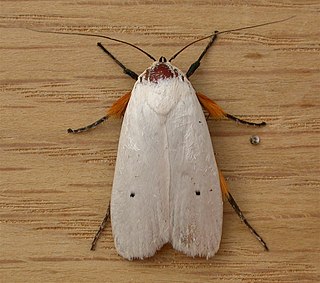
The fruit tree borer is a moth of the family Xyloryctidae. It is native to Australia.

Phalaenoides is a genus of moths of the family Noctuidae. The genus was erected by John Lewin in 1805.

Eudocima materna, the dot-underwing moth, is a moth of the family Erebidae found in widespread parts of the world, mainly in tropical Asia extending to New Guinea and Australia as well as in Africa. Reports from the United States, Canada and the French Antilles are now considered to be Eudocima apta. The species can be differentiated from other Eudocima moths by the presence of small central black dot in each hindwing. The species was first described by Carl Linnaeus in his 1767 12th edition of Systema Naturae.

Thyas coronata is a species of moth of the family Noctuidae first described by Johan Christian Fabricius in 1775. It is found from the Indo-Australian tropics of southern China, Taiwan, Japan, Nepal, India, Sri Lanka to Micronesia and the Society Islands.

Ophiusa disjungens, the guava moth, is a moth of the family Erebidae. The species was first described by Francis Walker in 1858. It is found in south-east Asia and the south Pacific, including Thailand, Japan, Tonga and New South Wales and Queensland. The adult is a fruit piercer.

Eudocima phalonia, the common fruit-piercing moth, is a fruit piercing moth of the family Erebidae. The species was first described by Carl Linnaeus in his 1763 Centuria Insectorum. It is found in large parts of the tropics, mainly in Asia, Africa and Australia but introduced into other areas such as Hawaii, New Zealand and the Society Islands. It is one of major fruit pests in the world.

Eudocima cocalus, the cocalus fruit piercing moth, is a moth of the family Erebidae. It is found in the north-eastern part of the Himalaya, to Sundaland and east to Queensland, Australia and the Solomons.
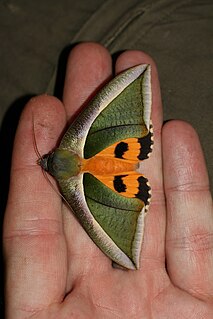
Eudocima salaminia, the green fruit-piercing moth, is a moth of the family Erebidae. The species was first described by Pieter Cramer in 1777. It is found from India, and across south-east Asia to the Pacific Islands. In Australia it occurs in the Northern Territory, Queensland and New South Wales. The adult is a fruit piercer.

Pseudosphinx is a monotypic moth genus in the family Sphingidae first described by Hermann Burmeister in 1856. Its only species, Pseudosphinx tetrio, was first described by Carl Linnaeus in 1771. Its common names include tetrio sphinx, giant gray sphinx, frangipani hornworm, and plumeria caterpillar. In the island of Martinique it is best known as Rasta caterpillar because of its colors which are reminiscent of the ones found in Rastafarian clothing and accessories. It is native to the tropical and subtropical Americas from the southern and southwestern United States to Brazil. The occasional individual has been recorded as far north as the northeastern United States.
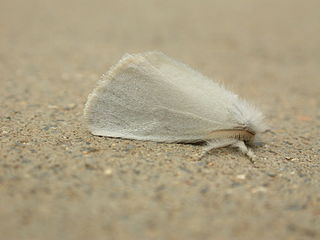
Acyphas semiochrea, the omnivorous tussock moth, is a moth of the subfamily Lymantriinae first described by Gottlieb August Wilhelm Herrich-Schäffer in 1855. It is found along most of the coast of Australia, including: New South Wales, Queensland, South Australia, Tasmania, Victoria and Western Australia.

Cizara ardeniae, the coprosma hawk moth, is a moth of the family Sphingidae. The species was first described by John Lewin in 1805. It is known from the eastern coastal region of Australia and New Zealand.

Creatonotos gangis is a species of arctiine moth found in South East Asia and Australia. It was described by Carl Linnaeus in his 1763 Centuria Insectorum.

Serrodes campana is a species of moth of the family Erebidae first described by Achille Guenée in 1852. It is found from the Indo-Australian tropics to eastern Australia, Fiji, Samoa and New Caledonia. It is also present in Japan, Korea and Sri Lanka. The adult is a fruit piercer, but also feeds on flower nectar.
